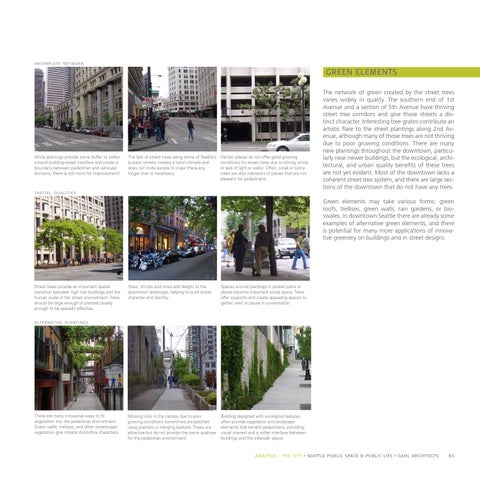i n com p l ete n et w ork
green elements
While plantings provide some buffer to soften a harsh building-street interface and create a boundary between pedestrian and vehicular domains, there is still room for improvement!
The lack of street trees along some of Seattle’s busiest streets creates a harsh climate and does not invite people to linger there any longer than is necessary.
Certain places do not offer good growing conditions for street trees due to strong winds or lack of light or water. Often, small or sickly trees are also indicators of places that are not pleasant for pedestrians.
The network of green created by the street trees varies widely in quality. The southern end of 1st Avenue and a section of 5th Avenue have thriving street tree corridors and give those streets a distinct character. Interesting tree grates contribute an artistic flare to the street plantings along 2nd Avenue, although many of those trees are not thriving due to poor growing conditions. There are many new plantings throughout the downtown, particularly near newer buildings, but the ecological, architectural, and urban quality benefits of these trees are not yet evident. Most of the downtown lacks a coherent street tree system, and there are large sections of the downtown that do not have any trees.
s p at i a l q u a l i t i e s
Green elements may take various forms: green roofs, trellises, green walls, rain gardens, or bioswales. In downtown Seattle there are already some examples of alternative green elements, and there is potential for many more applications of innovative greenery on buildings and in street designs.
Street trees provide an important spatial transition between high rise buildings and the human scale of the street environment. Trees should be large enough or planted closely enough to be spatially effective.
Trees, shrubs and vines add delight to the downtown landscape, helping to build street character and identity.
Spaces around plantings in pocket parks or plazas become important social space. Trees offer supports and create appealing spaces to gather, wait or pause in conversation.
Missing links in the canopy due to poor growing conditions sometimes are patched using planters or hanging baskets. These are attractive but do not provide the same qualities for the pedestrian environment.
Building designed with ecological features often provide vegetation and landscape elements that benefit pedestrians, providing visual interest and a softer interface between buildings and the sidewalk space.
a l te rn at i v e p l a nt i n g s
There are many innovative ways to fit vegetation into the pedestrian environment. Green walls, trellises, and other streetscape vegetation give streets distinctive characters.
ANALYSIS - TH E CITY • SEATTLE PUBLIC SPACE & PUBLIC LIFE • GEHL ARCHITECTS
63
